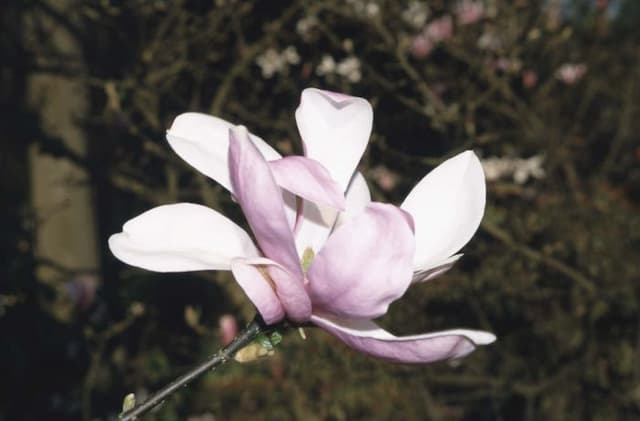Evergreen magnolia Magnolia grandiflora



ABOUT
Magnolia grandiflora is a large evergreen tree that commonly reaches heights of 40 to 80 feet and widths of 40 to 60 feet.
Its leaves are obovate, leathery, and dark green in color, usually measuring 3 to 8 inches in length and 2 to 4 inches in width. Its undersides are a lighter color and appear to be covered in a rust colored fuzz. The leaves are also known to be quite fragrant when crushed.
Magnolia grandiflora has large, showy, white flowers that range in size from 4-10 inches in diameter. The outer petals appear waxy, have a pointed tip and are slightly downturned. At the center of the flower are hundreds of yellow-tipped stamens.
In fall, small, cone-like red fruits are produced, each containing a single seed.
About this plant
 Names
NamesFamily
Magnoliaceae
Synonyms
Bullbay, Great laurel-leaved magnolia, Large-flowered magnolia, Laurel magnolia, Loblolly magnolia, Southern magnolia
Common names
Magnolia angustifolia, Magnolia elliptica, Magnolia foetida
 Toxicity
ToxicityTo humans
The Magnolia grandiflora plant is not considered toxic to humans if ingested, and there are no known serious side effects to humans. However, if any part of the plant is ingested, it may cause minor digestive upset such as nausea, vomiting and diarrhea. The sap and pollen of this plant may be a skin irritant and cause ingestion, so it is best avoided. In addition, people with skin allergies or sensitivities should avoid contact with the plant.
To pets
Magnolia grandiflora, also known as Southern Magnolia, is toxic to animals if ingested. Symptoms of poisoning include vomiting, abdominal pain and discomfort, paralysis, lethargy, convulsions and ataxia. If eaten in large enough quantities, Magnolia grandiflora can be fatal to animals.
 Characteristics
CharacteristicsLife cycle
Perennials
Foliage type
Evergreen
Color of leaves
Green
Flower color
White
Height
Up to 80 feet
Spread
Up to 60 feet
Plant type
Shrub
Hardiness zones
6
Native area
Southeastern United States
Benefits
 General Benefits
General BenefitsBeauty: Magnolia grandiflora is a large evergreen tree that is prized for its striking, glossy, dark green leaves and its showy white blossoms.
Fragrance: With its large, fragrant blooms, Magnolia grandiflora adds both charm and an inviting fragrance to a garden or landscape.
Shade: Magnolia grandiflora provides a great source of shade in hot summer months, making it a great addition for outdoor living spaces.
Diversity: Magnolia grandiflora comes in a variety of shapes, sizes, colors, and textures. Its foliage even colors to a yellow-bronze in the winter.
Wildlife: Magnolia grandiflora attracts wildlife such as bees, butterflies, and hummingbirds to your outdoor space.
Longevity: With proper care, Magnolia grandiflora can live for decades, making it a timeless classic for gardens and landscapes. Medical Properties
Medical PropertiesCardiovascular Health: Magnolia grandiflora contains several compounds that act as antioxidants by helping to reduce inflammation, prevent damage from free radicals, and protect the heart.
Antispasmodic: Magnolia grandiflora is known to have antispasmodic properties which can help to relax the muscles and can help reduce cramping and spasm in the body.
Nervous System Support: Magnolia grandiflora can help to calm and soothe the nervous system, and is believed to be useful in treating depression and anxiety.
Anti-Inflammatory: The flavonoids and phenolic compounds present in Magnolia grandiflora can help to reduce inflammation in the body, which can help to reduce pain and support the body's natural healing process.
Antiviral: Magnolia grandiflora contains compounds that can help to protect against viruses.
Digestive Support: The compounds present in Magnolia grandiflora can act as a laxative and help to promote a healthy digestive tract.
Diabetes Support: Studies have found that Magnolia grandiflora can help to reduce the risk of developing type 2 diabetes by promoting healthy insulin levels.
Respiratory Health: Magnolia grandiflora has been found to have a protective effect on the respiratory system, and can be used to treat respiratory infections and allergies.
Do not use this plant as a treatment without consulting your doctor. Air-purifying Qualities
Air-purifying QualitiesThe Magnolia grandiflora plant has been found to be an effective air purifier, as it has the ability to absorb various airborne pollutants, including volatile organic compounds, particulate matter, nitrogen dioxide, and ozone. The plant is also known for its natural scent, making it a useful addition to air purification systems.
 Other Uses
Other UsesOrnamental Seedpods: Magnolia grandiflora's uniquely shaped seedpods can be used to decorate both indoor and outdoor areas for an attractive, nature-inspired touch.
Crafting Material: Magnolia's seedpods, leaves, petals, and bark can all be used to create jewelry and other crafts.
Shade or Privacy: The leaves of Magnolia grandiflora provide ample shade as well as privacy.
Wall Cladding: Magnolia grandiflora's bark can be dried and cut into strips to create a unique wall cladding.
Animal Bedding: Dried Magnolia grandiflora's leaves make a great bedding for small animals, providing excellent insulation and comfort.
Soap Making: Magnolia's petals, leaves, and bark can all be used in soap and skincare recipes.
Insect Repellent: A mashup of the Magnolia grandiflora leaves can be used to create an all-natural insect repellent.
Interesting Facts
 Feng Shui
Feng ShuiIn Feng Shui, using Magnolia grandiflora can bring balance and harmony to the home or garden. It is said that this plant has the ability to enhance good luck, abundance and health. Plant it to the right of the entrance door to bring good fortune, in the home office to promote focus and productivity, or in the bedroom to create peaceful and restful energy. It can also be used in the garden to attract spiritual energies.
 Zodiac Sign Compitability
Zodiac Sign CompitabilityThe Magnolia grandiflora aligns best with the zodiac sign Taurus. The sign of Taurus is represented by a bull's head, symbolizing the stubbornness and strength associated with the sign which is paralleled by the Magnolia's resilience and boldness.
Taurus is also ruled by the planet Venus and is associated with things such as beauty, loyalty, warmth and nurturing, which is demonstrated by the Magnolia's vibrant color and sweet-smelling blossoms. As such, this combination perfectly encapsulates the Magnolia grandiflora's strong yet gentle and beautiful nature. Plant Symbolism
Plant SymbolismIt is a symbol of the southern people’s unwavering spirit and determination to overcome the odds. It is also a symbol of femininity and beauty, as the white flowers are often associated with purity and innocence. Finally, the magnolia grandiflora is associated with peace, serenity, and natural beauty, representing the wonder and majesty of the South.
 Water
WaterMagnolia grandiflora should be watered deeply and slowly approximately once a week. Deep watering encourages deep roots and helps to avoid shallow roots.
When watering, soak the root zone for about 15-20 minutes so that water is able to penetrate deep into the soil. Magnolia grandiflora should not be watered too frequently as this could lead to root rot or other fungal diseases. About 2-3 inches of water should be provided in a single watering. Light
LightThe best light conditions for Magnolia grandiflora is bright, indirect sunlight. The best spot for the plant is an area that receives morning sunlight but is shaded during the hottest part of the day.
 Temperature
TemperatureIn terms of temperature, the plant prefers summer temperatures between 65 and 75°F, and winter temperatures between 55 and 65°F.
 Pruning
PruningMagnolia grandiflora should be pruned in late winter or early spring, before new growth begins in the spring. Pruning should focus on removing dead, broken, and diseased branches, and thinning out overcrowded branches. To shape the plant and create flowering opportunities, prune weak or thin branches, as well as crossing branches, removing no more than one-third of the plant's foliage during any single pruning session.
 Cleaning
CleaningNot needed
 Soil
SoilFor the best soil mix for Magnolia grandiflora, a mixture of 2 parts loamy soil, 1 part compost and 1 part perlite is recommended. To achieve the right acidity, the soil pH should be between 5.0 and 6.5.
 Repotting
RepottingIt is an outdoor tree, so transplanting is not required.
 Humidity & Misting
Humidity & MistingFor Magnolia grandiflora, the best humidity conditions are a relative humidity of 45% - 60%.
 Suitable locations
Suitable locationsIndoor
Not growing
Outdoor
All year round
Hardiness zone
7 - 9 USDA
 Life cycle
Life cycleThe tree begins its life as a small seedling, which grows slowly for the first few years before picking up the pace as it matures. The leaves of Magnolia grandiflora are large, glossy, and dark green, measuring up to 10 inches long and 5 inches wide, and remain on the tree year-round.
In the spring and summer months, the tree produces large, showy, fragrant flowers that can measure up to 12 inches in diameter. These flowers are creamy white with a waxy texture and have a lemony fragrance.
After the flowers have bloomed, the tree produces cone-like fruits, which can contain up to 200 bright red seeds. The fruits mature and split open in the fall, revealing the seeds.
As the tree ages, its bark becomes thick and rough, with deep furrows and ridges. Magnolia grandiflora can live for up to 120 years in ideal growing conditions. Propogation
PropogationPropogation time
Spring, summer, fall
Seeds:
Seeds should be collected from mature Magnolia grandiflora plants in autumn. The seeds should then be planted in a sunny location and covered with a layer of mulch or clean sand. Make sure the planting site has well-draining, acidic soil and a pH between 5.5 and 6.5. The seeds will germinate in the spring once the soil temperature reaches approximately 62-68 degrees Fahrenheit.
Grafting:
Grafted Magnolia grandiflora plants can be purchased from nurseries. Propagation can also be accomplished by taking cuttings from existing plants and grafting them onto a new rootstock. Magnolia grandiflora is compatible with a variety of other Magnolia species, so it is best to do a bit of research prior to grafting to determine which species will provide the best graft.
Layering:
Layering is an easy way to propagate Magnolia grandiflora. Find a healthy mature branch on the plant and scrape away the bark at the base of the branch. Bury the bare area in soil and cover with a layer of mulch or compost. The branch should take root in approximately 6-12 months, at which point it can be cut away from the parent plant and transplanted to a new location. Make sure the new soil has the same acidic properties as the original soil.
 Pests
PestsBorer, Scale insects, Caterpillar
 Diseases
DiseasesAnthracnose, Root Rot, Powdery mildew, Leaf spot, Canker









![Magnolia [Black Tulip]](/_next/image?url=https%3A%2F%2Fplants-admin.emdemapps.com%2Fimages%2Fplants%2F%2Fimages%2F604b590290fc7.png&w=640&q=75)